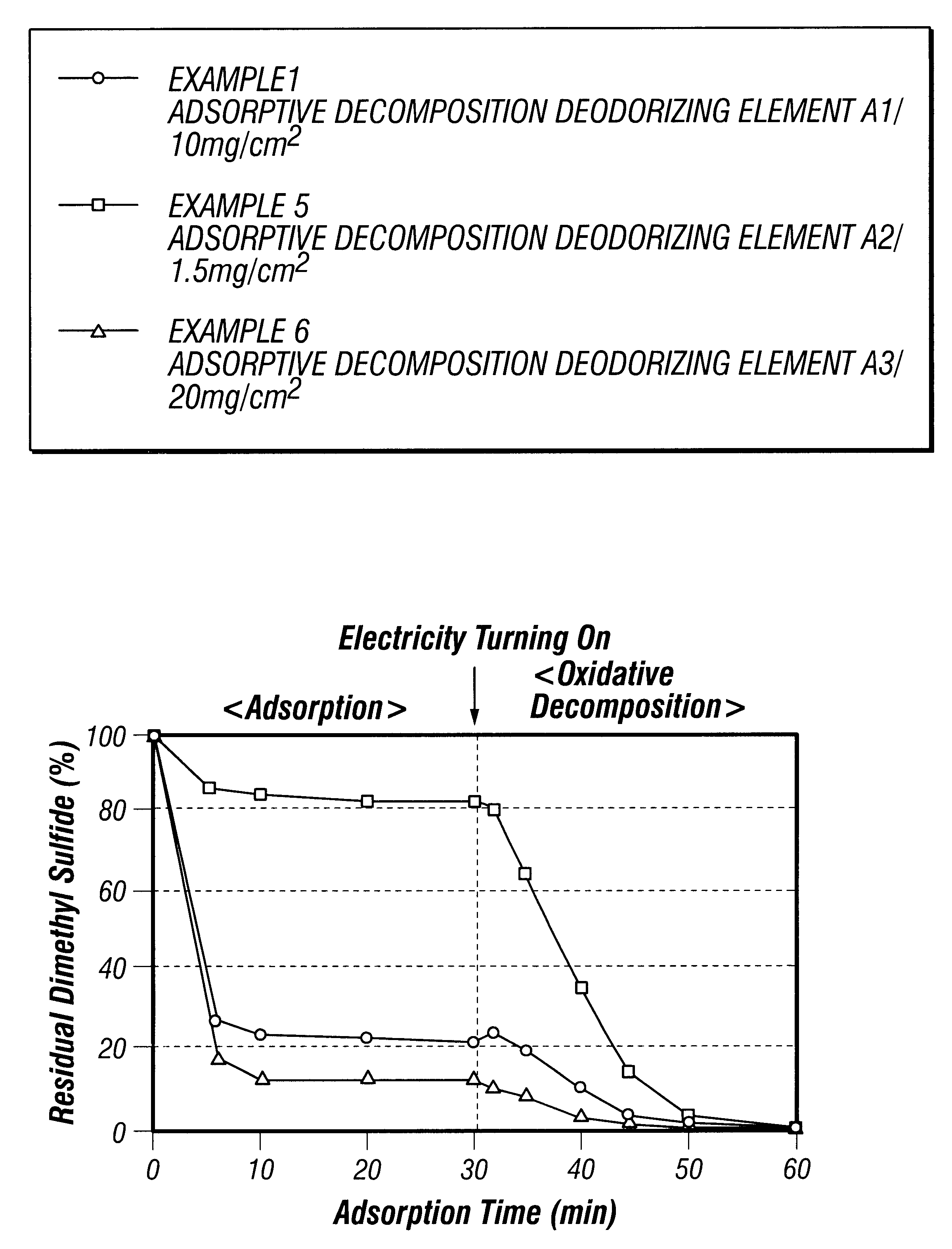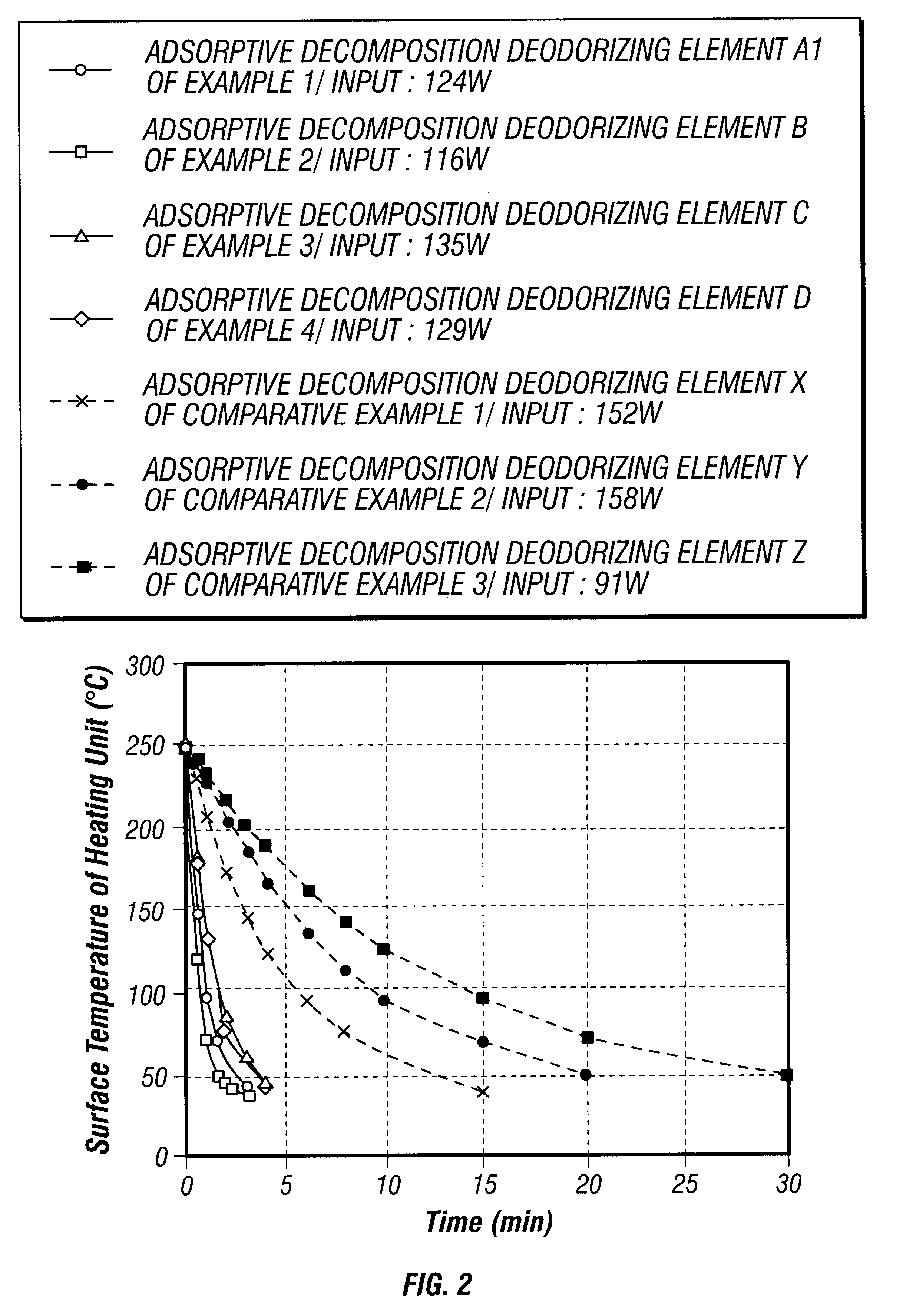Adsorption, decomposition deodorization element
a deodorizing element and decomposition technology, applied in the direction of dispersed particle separation, disinfection, separation processes, etc., can solve the problems of inability to achieve satisfactory temperature rise, and inability to achieve satisfactory heating speed, etc., to achieve no effective deodorizing
- Summary
- Abstract
- Description
- Claims
- Application Information
AI Technical Summary
Benefits of technology
Problems solved by technology
Method used
Image
Examples
example 1
Referring to FIGS. 6 and 7, a heating unit A includes an iron-chromium foil electrical heating unit 15 positioned between an upper soft mica paper sheet 20 and a lower soft mica paper sheet 25. The upper soft mica paper sheet 20 and the lower soft mica paper sheet 25 each have an outer surface, which together comprise the peripheral surface of the heating unit. Referring also to FIG. 8, the finished heating unit A includes the deodorizing unit 30, described above, located on the peripheral surface of the heating unit. The finished heating unit A has a thickness, T, and a width, W. The iron-chromium foil is 3,400 mm in full length, 0.053 mm in thickness and 1.2 mm in width and was molded into a zigzag configuration with folding intervals of 1.7 mm (width=30 mm, length of each folded part=300 mm) to thereby construct an electrical heating unit having an electrical resistance of 67 .OMEGA. and an electrical capacity of 150 W / 100 V.
Separately, soft mica paper sheets for electrical heati...
example 2
A heating unit B, which was 0.6 mm in thickness, 40 mm in width and 400 mm in length and weighed 21 g, was prepared by the same procedures as those described in Example 1 but using soft mica paper sheets for electrical heating of 0.3 mm in thickness as a substitute for those 0.5 mm in thickness. The heating unit B thus obtained had an effective heating length of 330 mm, an effective surface area of 264 cm.sup.2, an effective heating part weight of 17.35 g and a weight per effective unit surface area of 0.066 g / cm.sup.2.
Similar to Example 1, the deodorizing coating M was then quickly applied onto the effective heating parts of the heating unit B at a rate of 10 mg / cm.sup.2 on a dry basis to thereby give an adsorptive decomposition deodorizing element B having 2.64 g / element, on a dry basis, of the deodorizing coating M applied thereon was prepared. The adsorptive decomposition deodorizing element B thus obtained had a weight per effective unit surface area of 0.076 g / cm.sup.2. Table ...
example 3
Referring to FIG. 9, a heating unit C includes an iron-chromium heating wire 50 positioned within grooves or cuts 55 of an intermediate soft mica paper sheet 60 and wound around the sheet 60 in a spiral configuration. The intermediate soft mica paper sheet 60 and spirally wound wire 50 are positioned between an upper soft mica paper sheet 65 and a lower soft mica paper sheet 70. The upper soft mica paper sheet 65 and the lower soft mica paper sheet 70 each have an outer surface, which together comprise the peripheral surface of the heating unit C.
Similar to Example 1, soft mica paper sheets for electrical heating (manufactured by Nippon Mica Seisakusho) of 0.4 mm in thickness were cut into pieces of 40 mm in width and 400 mm in length. In one of these mica plates, cuts (1 mm in width, 5 mm in depth) were made in both ends in the width direction at intervals of 10 mm at the center in the length direction over 300 mm in such a manner as to alternately arrange the cuts in the both ends...
PUM
| Property | Measurement | Unit |
|---|---|---|
| thickness | aaaaa | aaaaa |
| thickness | aaaaa | aaaaa |
| thickness | aaaaa | aaaaa |
Abstract
Description
Claims
Application Information
 Login to View More
Login to View More - R&D
- Intellectual Property
- Life Sciences
- Materials
- Tech Scout
- Unparalleled Data Quality
- Higher Quality Content
- 60% Fewer Hallucinations
Browse by: Latest US Patents, China's latest patents, Technical Efficacy Thesaurus, Application Domain, Technology Topic, Popular Technical Reports.
© 2025 PatSnap. All rights reserved.Legal|Privacy policy|Modern Slavery Act Transparency Statement|Sitemap|About US| Contact US: help@patsnap.com



